Venice consists of 118 small islands connected by more than 400 bridges.
This floating city welcomes over 20 million visitors annually, and for good reason!
Venice is truly like nowhere else on Earth, with its maze of canals, stunning architecture, and rich cultural heritage that spans over a millennium.
With so many things to do in Venice, and limited time, planning your first visit to this Italian jewel can feel daunting.
That’s why I’ve created this guide!
Let’s dive into the 12 essential experiences every first-time visitor to Venice should have in 2025!
Glide Through History on a Traditional Gondola Ride
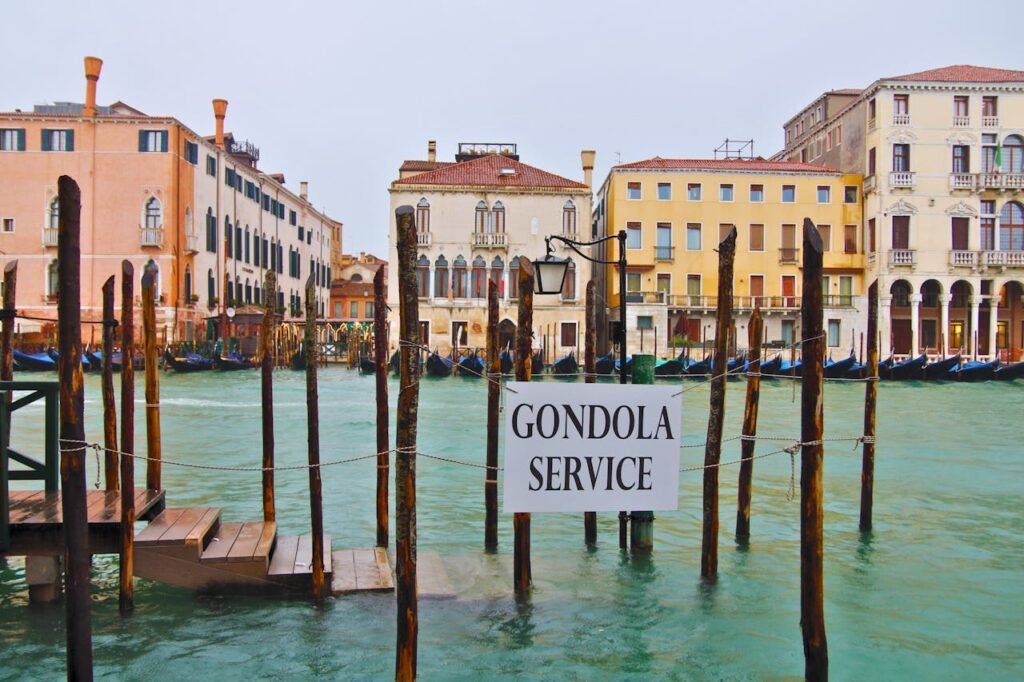
I’ll be honest – when I first visited Venice, I almost skipped the gondola ride thinking it was just an overpriced tourist trap.
What a mistake that would have been! Experiencing Venice from the water isn’t just beautiful; it’s essential to understanding the city’s soul.
These iconic black boats have navigated Venice’s canals for over 1,000 years!
Back in the day, gondolas were the main transportation for Venetians of all classes. Today, there are just around 400 licensed gondoliers who have earned their position through rigorous training and often family tradition going back generations.
The standard rate for a 30-minute gondola ride is about €80 during the day and €100 after 7 PM. Yes, it’s expensive! But here’s my tip – gather a group of up to six people to share the cost, as the price is per gondola, not per person.
And trust me, those intimate side canals away from the Grand Canal traffic are where the magic happens!
I’ve found the best times for gondola rides are either early morning (around 8-9 AM) when the city is still waking up, or during the golden hour just before sunset.
The mid-afternoon sun can be brutal in summer, and the most popular boarding points near Rialto and San Marco get incredibly crowded.
If your budget is tight, consider a traghetto – these are gondolas that simply ferry passengers across the Grand Canal at specific crossing points for just a couple of euros. You’ll stand rather than sit, but you’ll still get that authentic gondola experience!
Marvel at the Grandeur of St. Mark’s Square (Piazza San Marco)
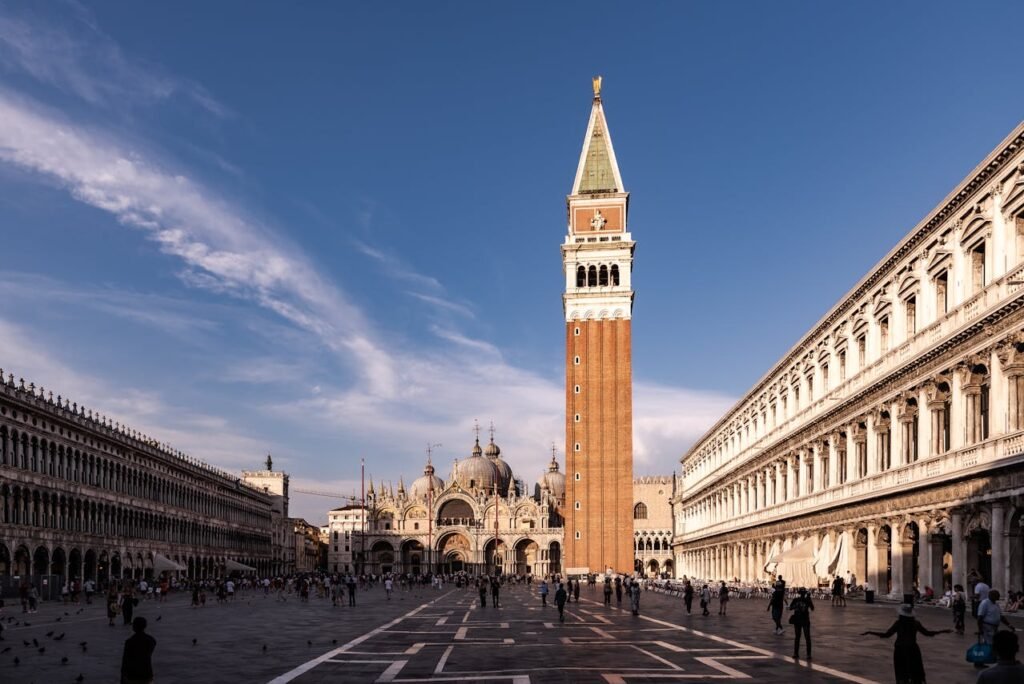
Napoleon once called it “the drawing room of Europe,” and standing in St. Mark’s Square, you’ll immediately understand why! This vast public square has been the social, political, and religious heart of Venice for over 900 years.
My first visit to the square was actually at dawn – I dragged myself out of bed at 5:30 AM, and it was totally worth it! Having this normally bustling space almost to myself, watching the sunlight gradually illuminate the basilica’s golden mosaics, was an experience I’ll never forget.
The square is surrounded by architectural marvels – St. Mark’s Basilica anchors the eastern end, while the elegant arcades of the Procuratie buildings line the north and south sides.
Don’t miss the ornate clock tower (Torre dell’Orologio) with its fascinating astronomical clock and the moving figures that strike the hour.
You’ve probably heard about the famous café orchestras that play in the square. Caffè Florian and Caffè Quadri have been serving patrons since the 1700s! Yes, sitting down will cost you a pretty penny (expect to pay €15+ for a coffee due to the “music charge”).
Oh, and keep an eye out for the square’s resident pigeons – they’re practically celebrities here! Although feeding them is now prohibited for conservation reasons, they’re still very much part of the St. Mark’s experience.
Explore the Opulent Doge’s Palace (Palazzo Ducale)
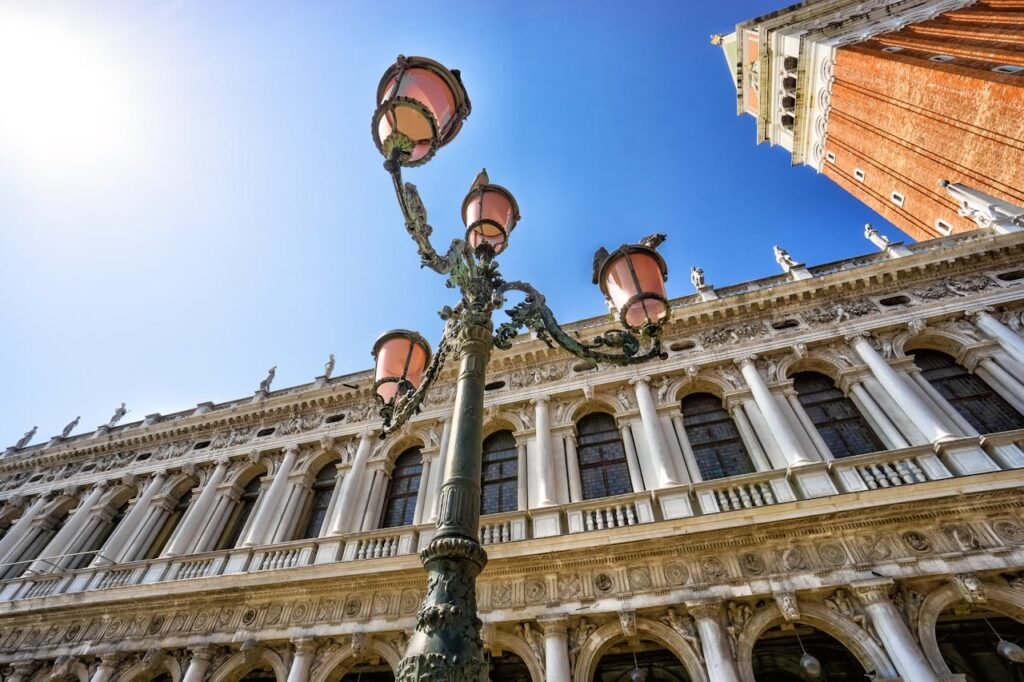
I still remember walking into the Great Council Chamber for the first time and literally gasping at the sight of Tintoretto’s “Paradise” – the largest oil painting in the world! Its beside the St. Mark’s Square.
The Doge’s Palace isn’t just another pretty building; it’s a powerful symbol of Venice’s former status as a maritime superpower.
The Doges (elected leaders of the Venetian Republic) ruled from this Gothic-Renaissance masterpiece for over 700 years.
The most fascinating part for me was the Secret Itineraries Tour. It’s a separate ticket, but so worth it! This guided experience takes you through the hidden passageways, interrogation rooms, and even the prison cells where the infamous Casanova was held before his daring escape.
Don’t miss crossing the enclosed Bridge of Sighs, named because prisoners would supposedly sigh as they caught their final glimpse of beautiful Venice before imprisonment.
The view from inside the bridge isn’t particularly special, but the experience of walking the same path as countless historical figures is powerful.
A standard ticket costs around €25, and I’d recommend allowing at least 2-3 hours for your visit.
Experience the Byzantine Splendor of St. Mark’s Basilica
I’ve visited many churches throughout Italy, but nothing prepared me for the golden glow inside St. Mark’s Basilica.
Over 85,000 square feet of gold mosaics cover the domes and walls, creating an atmosphere that feels more Byzantine than Italian – and that’s exactly the point!
Venice wanted to showcase its connections to the exotic East.
The church was originally built to house the stolen remains of St. Mark, which Venetian merchants smuggled out of Alexandria in a barrel of pork fat (to deter Muslim inspectors from checking their cargo).
When you visit, be sure to see the Pala d’Oro, an incredible gold altarpiece studded with nearly 2,000 gems. For an extra fee, you can access the museum and the loggia, which offers stunning views over St. Mark’s Square.
Remember that this is an active place of worship, so dress appropriately – shoulders and knees must be covered. I once saw several tourists turned away on a hot summer day for wearing tank tops and shorts, so come prepared!
Entry to the basilica itself is free, but I strongly recommend booking a skip-the-line timeslot online for €5. Trust me, those €5 will be the best money you spend in Venice!
Get Lost in Venice’s Charming Streets and Canals
“Getting lost in Venice is the only way to discover it.” A local told me this on my first visit.
I spent one afternoon just following wherever my feet took me in the Dorsoduro district, and stumbled upon a tiny bookbinder’s workshop where an elderly craftsman was creating marbled paper using centuries-old techniques.
The sestieri (districts) of Cannaregio and Castello offer the most “local” feel, with neighborhood squares (campi) where Venetian children play and residents gather to chat.
The Jewish Ghetto in Cannaregio is particularly fascinating – look up at the unusually tall buildings, designed to accommodate more people in the restricted space Jews were allocated.
Don’t worry too much about getting seriously lost – Venice is relatively small, and you’re never far from a sign pointing to “Per Rialto” or “Per San Marco.” These yellow signs on building corners will guide you back to the main landmarks when you’re ready.
Cross the Iconic Rialto Bridge
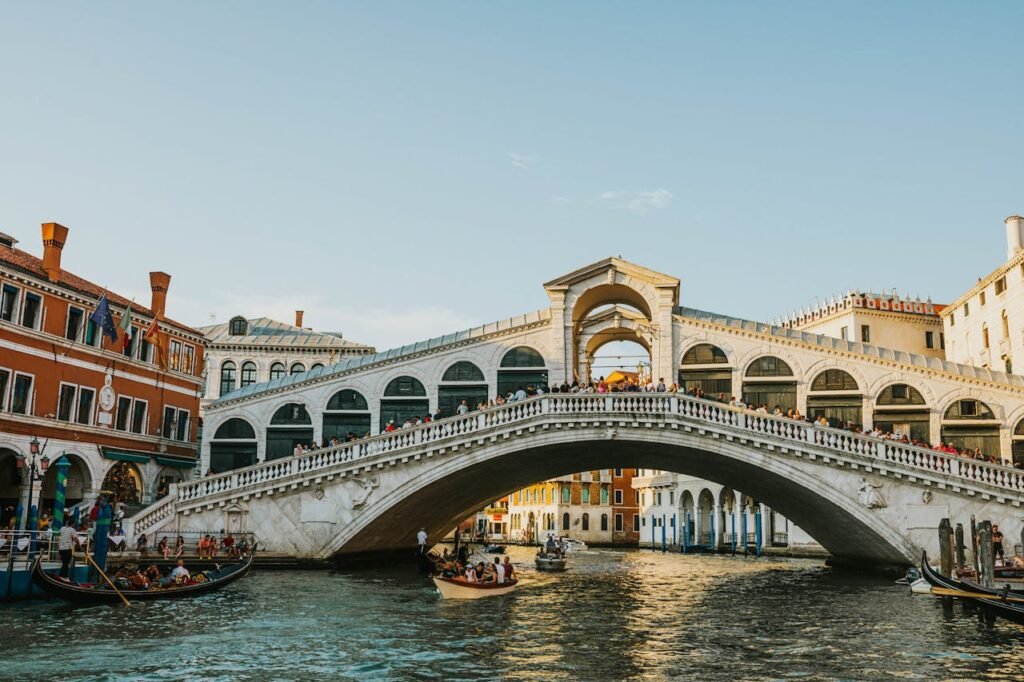
The Rialto Bridge isn’t just another pretty photo opportunity – it’s a testament to engineering innovation and Venetian determination.
When it was proposed to build a stone bridge with a single 90-foot span over the Grand Canal in the late 16th century, many thought it would collapse. Yet here it stands over 400 years later!
My favorite time to visit is actually in the early morning, around 7 AM, when delivery boats are bringing fresh goods to the nearby Rialto Market, continuing a tradition that’s been going on for centuries. The light at this hour is perfect for photography, and you’ll have plenty of space to appreciate the bridge’s elegant design.
The bridge itself is lined with shops selling jewelry, Murano glass, and souvenirs – a continuation of its historical role as a commercial center. While most are touristy, a few quality artisans remain if you look carefully.
For the iconic postcard view of the bridge, head to the vaporetto stops on either side of the Grand Canal. I prefer the view from the San Bartolomeo side in the late afternoon when the sunlight bathes the white stone.
After crossing the bridge, don’t miss the Rialto Market (closed Sundays and Monday afternoons). The fish market (Pescheria) offers a fascinating glimpse into Venetian daily life, with locals carefully selecting seafood fresh from the lagoon and Adriatic Sea.
Visit the Colorful Islands of Murano, Burano, and Torcello
Escaping the main islands of Venice to explore the outer lagoon was one of the best decisions I made during my visit!
Each island has its own distinct character and pace, offering a different perspective on Venetian culture.
Murano, famous for its glassmaking tradition since 1291, is just a 10-minute vaporetto ride from northern Venice. I recommend visiting a glass factory demonstration first thing in the morning – it’s mesmerizing to watch master craftsmen transform molten blobs into delicate sculptures in seconds!
The Glass Museum (Museo del Vetro) provides excellent context for understanding this art form’s significance.
Burano took my breath away with its rainbow-colored fishermen’s houses. Legend says the bright colors helped sailors find their way home through the lagoon fog. Today, strict regulations ensure this unique aesthetic continues.
The Lace Museum showcases this painstaking art that once adorned royal courts throughout Europe.
Torcello is my personal favorite – this nearly abandoned island was actually the first settlement in the Venetian lagoon!
Today, fewer than 20 people live here, but the magnificent 7th-century Cathedral of Santa Maria Assunta houses some of the oldest and most stunning Byzantine mosaics in Italy. The peaceful atmosphere makes it hard to believe this was once more populous than Venice itself.
To visit all three islands comfortably, start early (around 8:30 AM) and purchase a 24-hour vaporetto pass (€21). Follow this route: Venice → Murano (1-2 hours) → Burano (2-3 hours) → Torcello (1 hour) → back to Venice.
Bring water and snacks for Torcello, as food options are limited there!
Take in Panoramic Views from the Campanile
I still remember the moment I stepped out of the elevator at the top of St. Mark’s Campanile and literally gasped at the 360-degree view. At 323 feet tall, this brick bell tower offers the most comprehensive panorama of Venice and its lagoon.
The current tower is actually a reconstruction – the original collapsed suddenly in 1902!
From the top, you can truly appreciate Venice’s unique layout – the S-shaped Grand Canal winding through the city, the terracotta roofscape interrupted by church domes, and on clear days, the snowcapped Dolomite mountains in the distance.
The best time to visit is either first thing in the morning (it opens at 9:30 AM) or in the evening around sunset. I went about an hour before closing time and was rewarded with golden hour lighting that made for stunning photos.
Tickets cost about €10, and unlike many Venice attractions, lines usually move quickly thanks to the efficient elevator system. Still, in peak season, consider booking a timed entry online.
If you’re looking for alternative viewpoints, the rooftop terrace of the T Fondaco dei Tedeschi department store near the Rialto Bridge offers free panoramic views (though you need to book a time slot), and the bell tower of San Giorgio Maggiore island provides a perfect view back toward St. Mark’s.
Immerse Yourself in Art at the Gallerie dell’Accademia
Accademia Gallery, this museum houses the most important collection of Venetian painting in the world, showcasing the distinctive colorful style that made the Venetian school famous.
The collection spans from Byzantine-influenced gold-ground panels to the rich colors of Titian and the dramatic, large-scale works of Tintoretto and Veronese.
Absolute highlights include Giorgione’s mysterious “The Tempest,” Titian’s final, emotionally charged “Pietà,” and Veronese’s massive feast scenes.
But the star for many visitors is Tintoretto’s action-packed “Miracle of the Slave” – I stood before it for nearly 20 minutes, discovering new details each moment!
The museum underwent major renovations recently, making the experience much more enjoyable with improved lighting and information. Plan to spend at least 2 hours here – art lovers could easily spend half a day.
A practical tip: the museum is located in Dorsoduro, across the Accademia Bridge from San Marco. Combine your visit with exploration of this artsy district, including a stop at the Peggy Guggenheim Collection nearby if modern art interests you.
The standard ticket is €12, but check for combined tickets if you plan to visit multiple state museums.
Explore the Jewish Ghetto’s Rich Heritage
Walking into Venice’s Jewish Ghetto feels like stepping into a different city altogether. The architecture suddenly shifts – buildings stretch unusually tall because residents were confined to this small area but needed space to grow.
Established in 1516, the ghetto was an enclosed area where Jews were required to live and was locked at night. Despite these restrictions, a rich Jewish culture flourished here.
Five synagogues were built, hidden within ordinary-looking buildings because external religious decoration wasn’t permitted.
These “hidden synagogues” are architectural gems, with interiors that contrast dramatically with their plain exteriors.
The campo (square) at the center of the Ghetto Nuovo feels deeply poignant, especially the Holocaust memorial along one wall with its stark bronze reliefs by Lithuanian sculptor Arbit Blatas.
While Venice’s Jewish community is now small, with only about 450 members, it maintains an active presence.
After your visit, stop at one of the kosher bakeries for traditional Venetian-Jewish pastries like the sweet “orecchie di Aman” (Haman’s ears) or savory “matzot pizza.” The museum and guided tours cost about €12, and I’d recommend booking in advance, especially for English tours which tend to fill up quickly.
Experience an Authentic Venetian Performance
Venice’s rich musical heritage extends far beyond the street musicians in St. Mark’s Square!
This city gave birth to opera as we know it today and was home to composers like Vivaldi (the “Red Priest” who taught music at the Pietà orphanage).
My most memorable Venetian evening was attending a small chamber concert in the Church of San Vidal near the Accademia Bridge.
Listening to Vivaldi’s “Four Seasons” performed by musicians in period costume, in a 17th-century church with incredible acoustics, was an experience I still get goosebumps thinking about!
These concerts happen almost nightly and tickets start around €30.
For opera lovers, visiting the legendary La Fenice Opera House is essential.
After being destroyed by fire three times (hence the name “The Phoenix”), the current incarnation is a magnificent restoration of 18th-century splendor. Even if you don’t catch a performance, the guided tour (€12) is fascinating, revealing both the public spaces and the backstage areas.
For performance tickets, especially at La Fenice, book well in advance through their official website.
Dress code varies – La Fenice performances call for elegant attire, while church concerts are more casual (though still respectful).
Shop for Traditional Venetian Crafts
Venice’s artisanal traditions date back centuries, and bringing home an authentic piece of this craftsmanship makes for a meaningful souvenir.
However, the city is also flooded with imported knockoffs! Knowing where to shop makes all the difference.
Venetian masks have become iconic symbols of the city, particularly associated with Carnival celebrations.
For authentic handmade masks, I recommend Ca’ Macana in Dorsoduro or La Bottega dei Mascareri near the Rialto Bridge.
Both offer workshops where you can see artisans at work and even take mask-making classes! A quality handmade mask typically starts around €40, while the mass-produced versions sold in tourist shops might be €10-15.
For Murano glass, shopping on Murano island itself offers the most authentic experience.
For smaller items, the tiny shop Cesare Toffolo near Campo San Barnaba showcases exquisite flameworked pieces.
Venice also has a rich tradition of handmade paper and bookbinding.
Il Papiro and Legatoria Piazzesi create marbled papers using techniques unchanged for centuries. I bought a small journal with marbled covers that now holds my travel memories!
Remember that true artisanal products come with appropriate price tags reflecting the hours of skilled work invested in them. If something seems too cheap, it’s probably not authentic!
Take a Grand Canal Tour by Vaporetto
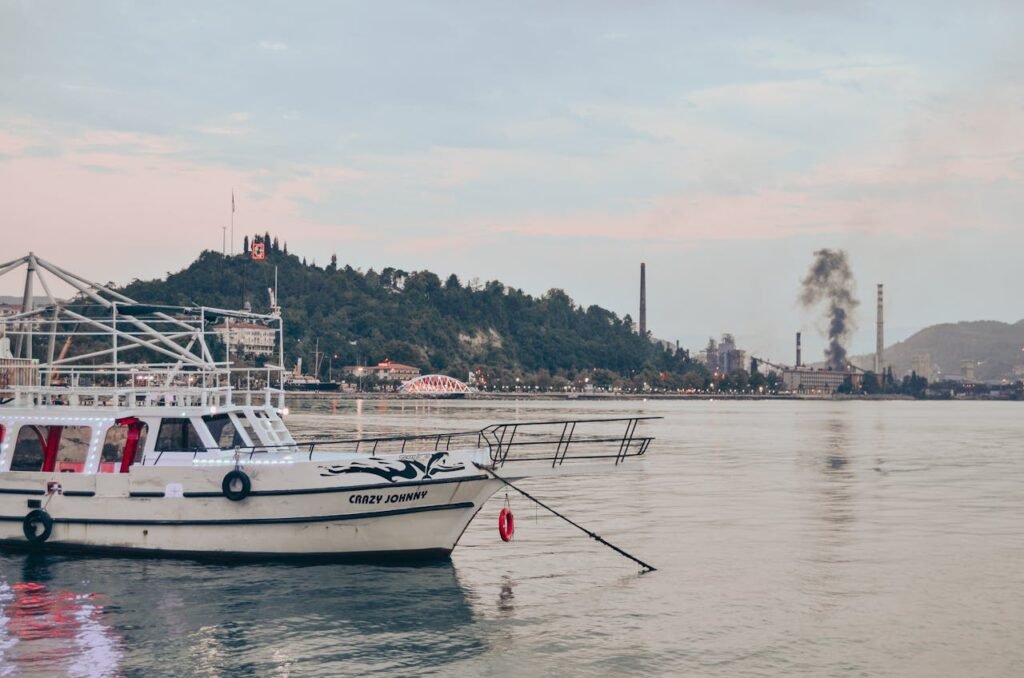
Sometimes the best experiences are also the most affordable!
One of my favorite Venice activities costs just the price of a vaporetto ticket (€7.50 for a single journey or €21 for a 24-hour pass).
Line 1 travels the entire length of the Grand Canal, Venice’s main waterway, passing under the Rialto Bridge and alongside dozens of magnificent palaces.
I recommend boarding at Piazzale Roma or the train station and riding all the way to San Marco. Grab a spot at the front of the boat or standing along the outside edge for the best views. The journey takes about 45 minutes and passes more than 170 buildings.
It’s like traveling through a living museum of architectural styles – Byzantine, Gothic, Renaissance, and Baroque facades line the banks, each telling stories of Venice’s wealthy merchant families.
Keep an eye out for Ca’ d’Oro (the “Golden House”), the imposing Palazzo Grimani, and the colorful Palazzo Dario, said to be cursed!
For the best light, take this journey in late afternoon when the western sun illuminates the eastern side of the canal beautifully.
For photography enthusiasts, I’d recommend this sequence: ride the full length once to get oriented, then make the return journey stopping occasionally at interesting spots. The vaporetto stops are perfectly positioned near many key attractions.
If you’re using a 24-hour pass, consider taking Line 2 as well, which follows a slightly different route with fewer stops, or explore the other lines that circle the main islands and venture out to Murano, Burano, and Lido.
Final Thought About Things to Do in Venice
After exploring these 15 essential experiences in Venice, you’ll understand why this floating city has captured the imagination of travelers for centuries.
From the grandeur of St. Mark’s Square to the simple pleasure of getting lost in quiet backstreets, Venice offers a perfect blend of iconic landmarks and authentic moments.
Remember that Venice rewards those who don’t rush.
While it’s tempting to try to see everything in a packed itinerary, some of your most memorable experiences will come from slowing down – sipping an espresso as the morning light plays across a small campo, or pausing on a bridge at sunset to watch gondolas glide silently below.
Buon viaggio!



